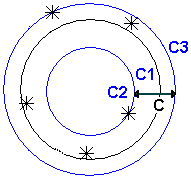Use the Compound Circle item to create a combined circle and reference plane item. You must probe a minimum of three points distributed around the circumference of the circle, and a minimum of three points for the plane.
To create a Compound Circle item:
- Open a Geometric group in the Sequence Tree.
- Click Geometry tab > Features panel > Circles > Compound Circle.
The Compound Circle dialog contains the following areas:
Name — Enter a name for the item. The name is used in the inspection sequence, in the Report and Info tabs, and when referencing the item in other items.
Use nominals — Select this check box to enter or change the item nominals, and to compare the item measurements to their nominal values. Deselect this check box to disable comparisons with the item nominals.
When this check box is selected, an in-tolerance
 or out-of-tolerance
or out-of-tolerance
 indicator is displayed on the measured item's icon in the inspection sequence; the border of the item
label is coloured to indicate whether the measurements are within tolerance; and the tolerance, nominal, deviation, and error values of the item are shown in the report.
indicator is displayed on the measured item's icon in the inspection sequence; the border of the item
label is coloured to indicate whether the measurements are within tolerance; and the tolerance, nominal, deviation, and error values of the item are shown in the report.
When this check box is deselected, the Nominal boxes are disabled, no tolerance indicators are displayed and no tolerance, nominal, deviation, and error values are shown in the report for this item.
 and select
From Active Measure.
and select
From Active Measure.
Visible — Select this check box to display the item in the CAD view.
Output in report — Select this check box to include the item in the report.
Coordinate system — Select the alignment relative to which the item's measurements are to be reported.
To specify the alignment during the inspection, select <Active Alignment>. You can then select the alignment from the Active alignment list, or by adding an Active Alignment item to the inspection sequence.
 Start angle — Enter the start angle of the feature relative to the
Orientation vector. You can enter the angle in degrees or radians.
Start angle — Enter the start angle of the feature relative to the
Orientation vector. You can enter the angle in degrees or radians.
 End angle — Enter the end angle of the feature relative to the
Orientation vector. You can enter the angle in degrees or radians.
End angle — Enter the end angle of the feature relative to the
Orientation vector. You can enter the angle in degrees or radians.
Material side — Choose the side from which you want to probe the feature. Select:
- Hole (ID) to probe an internal feature.
- Boss (OD) to probe an external feature.
- Not specified to leave the probing direction unrestricted.
Fitting algorithm — Choose the algorithm with which you want to calculate the item. Select:
- Least square to create the feature that minimizes the deviation across all probed points.
- Maximum inscribed to create the largest feature that fits within the probed points.
- Minimum circumscribed to create the smallest feature that fits around the outside of the probed points.
- Minimax to create the feature by averaging the maximum inscribed and minimum circumscribed features that have the same centre.
Centre — Enter the nominal and tolerances for the position of the feature's centre point.
Diameter — Enter the nominal and tolerances for the Radius or Diameter of the feature.
 to hide the label, and click
to hide the label, and click
 to redisplay it.
to redisplay it.
Circularity — Enter the Maximum acceptable difference between the points with greatest positive deviation and greatest negative deviation from the best-fit circle. If the difference between the greatest positive deviation and greatest negative deviation exceeds the Maximum value, the circularity is out-of-tolerance.
To measure circularity, PowerInspect calculates the best-fit circle, C1, through the points. It then runs two concentric circles through the points furthest from the new circle in each direction, shown as C2 and C3:

The Circularity value is the difference between the radii of C2 and C3.
Normal vector — Enter the nominal and tolerances for the normal vector of the plane.
Orientation — Select the vector from which the Start angle and End angle are calculated when creating a partial circle.
Auto-accept plane points — Select the check box to save the plane measurements as soon as you have probed the number of points specified in the Points box.
Auto-accept circle points — Select the check box to save the circle measurements as soon as you have probed the number of points specified in the Points box. Deselect a check box to choose how many points to probe and save your measurements manually.
Guided measure — Select this check box to restrict the probed points to the reference plane when measuring the feature with an articulated arm. Only points taken within the Capture tolerance (specified in the Feature Probing dialog) are recorded. To adjust the plane along its normal, such as when probing a hole, enter an Offset distance. This check box has no effect when probing the part with a CMM.
Click OK to close the dialog and save your changes.